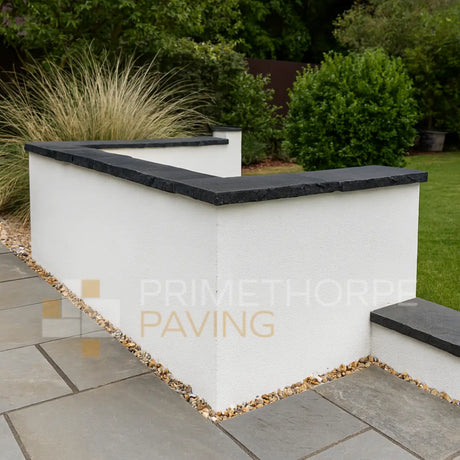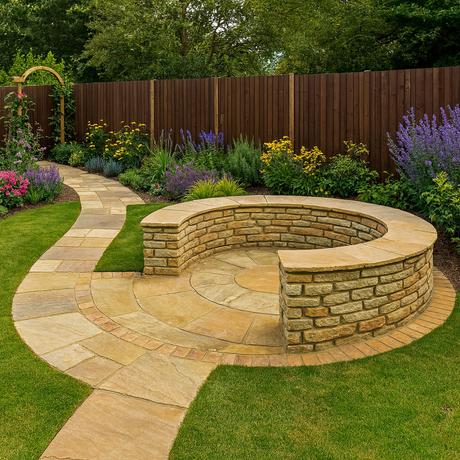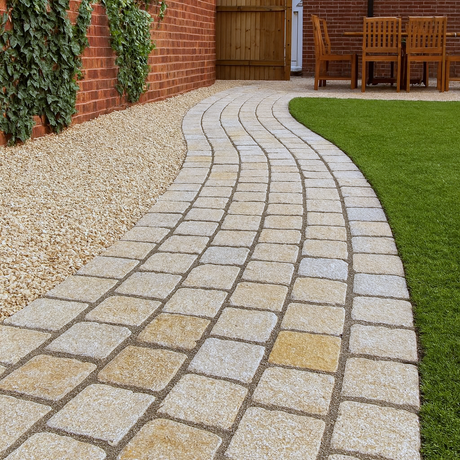How To Lay Paving Slabs On Sand - Simple: You Don't!
There are many guides on how to lay a patio that can be found online, but this article is going to talk specifically about what to use as the adhesive to secure the pavers to the sub-base. This is not a guide on how to lay paving slabs on sand, because long story short, you shouldn't!
Key Takeaways:
- Cement is Crucial: Cement acts as a binder and is essential for patio installation. It ensures the slabs are securely bonded to the sub-base, offering strength and longevity.
- Mortar Mix Ratios Vary: The ideal mix depends on factors like paving material and drainage needs. Common ratios can be: 4:1 (sand:cement), 5:1 or 6:1. We tend to recommend a 7:1 mix for standard garden patios.
- Weather Influences Water Quantity: The amount of water needed in your mortar mix can vary based on weather conditions and the moisture content in the sand.
- Consistency is Key: The ideal mortar consistency allows you to form a snowball-like shape without it falling apart.
- Additional Additives Enhance Mortar: Feb-mix can be added to the mortar to improve workability and prevent shrinking and cracking.
- Jointing Compounds Need a Solid Base: Joint-IT Jointing Compound, used for grouting, requires a solid mortar bed to function effectively and avoid patio slabs moving.
Can You Lay Paving Slabs on A Purely Sand Base?
Adhesive, or mortar as it is commonly named, is an absolute must in every patio installation (use our patio mortar calculator to see how much you need). Simply laying patio slabs on building sand is going to be a nightmare. Slabs are heavy items, but the pure weight of them are not going to be enough the help them bed down and stay put. You need a substance that is really going to get the slabs to bond with the ground and stay where they are. We highly recommend that cement is always added to the mortar mix to help with adhesion, strength and longevity of your patio.
The key ingredient for ensuring the life & success of your patio is cement. This will give your patio slabs enough to grip onto the base - laying without it means the slabs will come flying out of the ground at the first sign of bad weather.
Cement: What Is it?
To start with let us investigate the finer details of what cement is and why we feel cement is a must during patio installation. Cement is a binder, a dust-like product that sets, harden and adheres to other materials to bind them together. Cement is one of the worlds most used products and can be traced back as early as Roman times.
Cement is very rarely used on its own - it is most commonly combined with either Sand or Ballast or in some instances both. When used with sand, the by-product produced is commonly known as mortar - the perfect substance for binding your patio with the ground. Once you have mortar, you need to add water; without water, cement will not set and you will be left with a fragile mortar which isn't useful for much.
Please continue reading below as we discuss in greater detail the required quantities of each of the above to create the perfect mortar mix.
The Ratio for your Sand: Cement Mix
So how much cement, sand and water do we need and what is the best way to mix the 3 materials? The short answer is that quantities will vary depending on the installation situation. Variables such a paving material, sub-base quality, patio usage & the drainage required will ultimately determine how strong or weak your mortar mix may need to be. The most common ratios in order of popularity are:
- 4:1 mix of sand:cement - a very strong mix. Will be a very strong bond, but it is fairly non-porous.
- 6:1 mix of sand:cement - a porous mix. This is used commonly when a permeable patio is essential.
- 5:1 mix of sand:cement - a middle ground. Whilst it is the least common, it is probably suitable for most projects.
Mixing the mortar together by hand in a wheelbarrow is possible, but can extremely repetitive and physically draining not to mention that the mix consistency can be questionable, by far the easiest way, where possible is to use a cement mixer. A cement mixer produces a consistent mix with minimal physical exertion. Simply put the machine is doing all the hard work.
In our opinion a standard back garden patio installation with a good sub-base and substantial drainage, we would recommend a 7:1 mix which equates to 7 even parts of sand and 1 part cement. For example, if you have 70kg or sand you would require 10kg of cement.
For a driveway that will take small vehicles and therefore a higher strength would be required then a strong 4:1 mix would be advisable. Always read the cement mixers 'payload' before you start a mix as to not overfill, at the very least you may end up with the mixture overflowing onto the floor and in a worst-case scenario you may actually break the mixer if it is loaded too full.
Measuring Out Your Cement Mix
Measuring sand and cement can easily be achieved using buckets, but water quantities can be harder to master, variables such as weather and water content within the sand can make knowing how much water to add to your mix a bit of a challenge. In instances where the weather is hot and the sand is dry, you will need more water when compared with a cold and wet day. On a cold day, the sand will be saturated and therefore a lot less water is needed.
Our advice with water quantities would be to be patient when mixing and add little amounts of water during the first mix and see how the mixture reacts. It sounds obvious but you can always add a little more water but once you’ve added too much you cannot take the water back out. Always allow the mixture to mix for a few minutes between adding water. There can be a slight delay in the water taking effect and if too much is added too quickly you could end up with a mixture resembling the soup of the day.
The perfect consistency of paving mortar will allow you to roll the mix into a snowball like shape whilst staying intact.
Extra Additives for Cement
So, is sand, cement and water all that is really needed to create mortar? 100% that with those 3 materials you will create mortar although there is a recommended additive called Feb-mix that can be used. So, what is Feb-mix and what does it do?
Feb-mix is an air en-training plasticiser that is added to the mortar during the mixing procedure to help produce an easy to work with “butter like” consistency. Along with help to create an easy to use workable mortar it also helps prevent shrinking and crack as the mortar cures and hardens.

Finishing Up - Jointing or Grouting Your Patio
Another, often overlooked, reason for not simply laying on sand is the effort it would subsequently take to grout or "point" your patio slabs. This job can be done quickly, easily and efficiently with a product known as Joint-IT Jointing Compound. These are resin-based sand products that you can simply brush into the gaps on your patio to make the whole process a breeze.
However, without an adhesive mortar bed below this product, you will very quickly find your patio ruined. The jointing compounds are permeable, which means water will rush through them into the bed of your paving slabs. As a result, if you've only used sand, the base will turn to soft, mushy sand and your slabs will begin to slide around almost immediately. Not ideal! Therefore, if you wanted to use this revolutionary grouting solution, you would not be able to use a building sand base.
So Can You Ever Lay On Just Sand?
Are then any instances where a sand only mixture will be enough? Potentially on 50mm thick concrete slabs which measure 900mm x 600mm or something of the same equivalent you may “get away with“ using sand due to the sheer weight of the pieces alone. But be prepared that even with these huge slabs, over time there maybe movement'
We'd always, always recommend bedding slabs down. Whilst you may get away with it in some instances, the vast majority of slabs won't stay put when laid straight onto sand. We'd recommend bedding the slabs down with a simple mortar mix each and every time. Avoid laying straight on to sand as whilst it may be convenient, the headaches are simply not worth it.
Hopefully, the above article has helped you understand how to create your perfect mortar mix and why cement is an important element in the installation process. To us, if you are laying Indian Sandstone, Limestone, Slate or Porcelain Paving then cement is a must.






